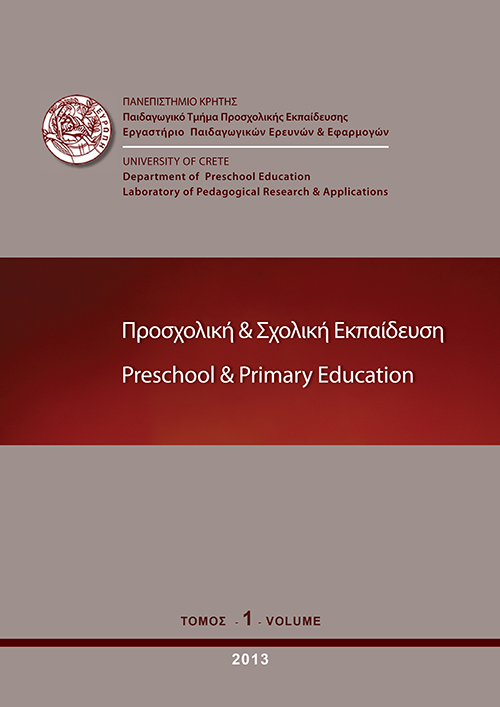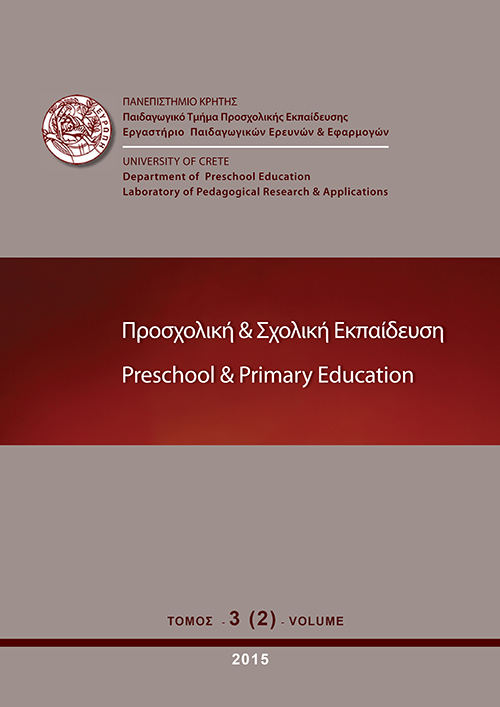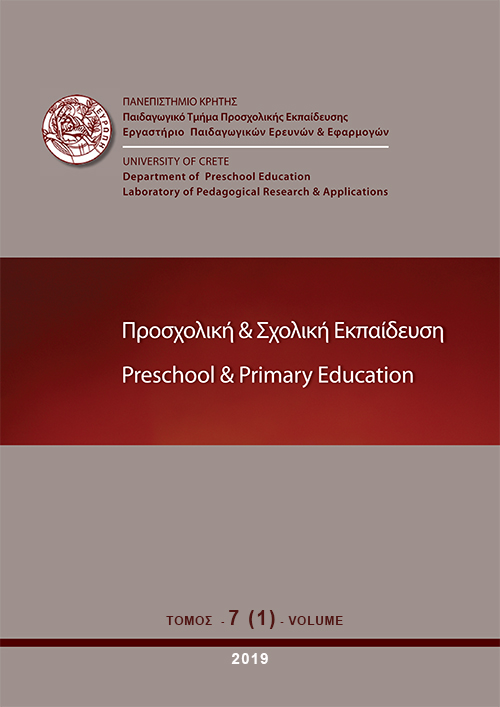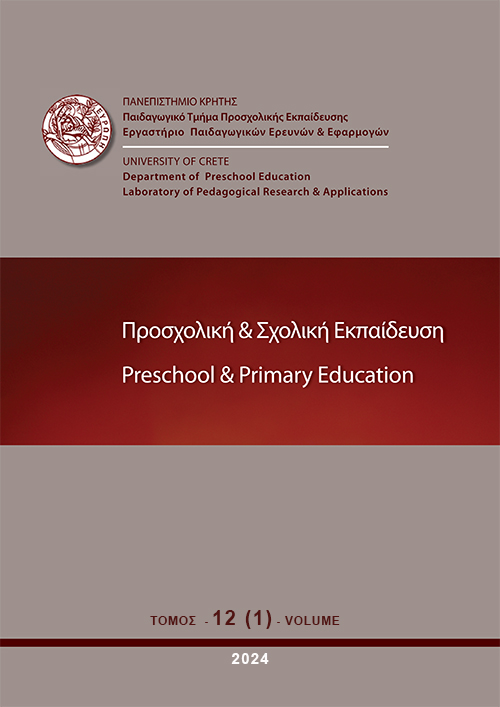Is rapid automatized naming automatic?
Аннотация
Article Details
- Как цитировать
-
Georgiou, G. K., & Stewart, B. (2013). Is rapid automatized naming automatic?. Preschool and Primary Education, 1, 67–81. https://doi.org/10.12681/ppej.46
- Выпуск
- Том 1 (2013)
- Раздел
- Άρθρα
Οι συγγραφείς των άρθρων που δημοσιεύονται στο ΠΡΟΣΧΟΛΙΚΗ & ΣΧΟΛΙΚΗ ΕΚΠΑΙΔΕΥΣΗ διατηρούν τα δικαιώματα πνευματικής ιδιοκτησίας επί των άρθρων τους, δίνοντας στο περιοδικό το δικαίωμα της πρώτης δημοσίευσης. Άρθρα που δημοσιεύονται στο ΠΡΟΣΧΟΛΙΚΗ & ΣΧΟΛΙΚΗ ΕΚΠΑΙΔΕΥΣΗ διατίθενται με άδεια Creative Commons 3.0 και σύμφωνα με την άδεια μπορούν να χρησιμοποιούνται ελεύθερα, με αναφορά στο/στη συγγραφέα και στην πρώτη δημοσίευση για μη κερδοσκοπικούς σκοπούς και με δικαίωμα τροποποίησης μόνον με παρόμοια διανομή (αν αναμείξετε, τροποποιήσετε, ή δημιουργήσετε πάνω στο υλικό, πρέπει να διανείμετε τις δικές σας συνεισφορές υπό την ίδια άδεια όπως και το πρωτότυπο). To Εργαστήριο Παιδαγωγικών Ερευνών και Εφαρμογών του Παιδαγωγικού Τμήματος Προσχολικής Εκπαίδευσης του Πανεπιστημίου Κρήτης και το Εθνικό Κέντρο Τεκμηρίωσης διατηρούν το δικαίωμα να δημοσιεύουν, να αναπαραγάγουν, να παρουσιάζουν στο κοινό, να διανέμουν και χρησιμοποιούν άρθρα που δημοσιεύονται στο ΠΡΟΣΧΟΛΙΚΗ & ΣΧΟΛΙΚΗ ΕΚΠΑΙΔΕΥΣΗ σε οποιοδήποτε μέσο και μορφή είτε μεμονωμένα είτε ως μέρη συλλογικών έργων, για όλο το χρόνο διάρκειας προστασίας της πνευματικής ιδιοκτησίας και για όλες τις χώρες του κόσμου. Αυτό περιλαμβάνει ενδεικτικά και όχι αποκλειστικά, το δικαίωμα δημοσίευσης των άρθρων σε τεύχη του περιοδικού ΠΡΟΣΧΟΛΙΚΗ & ΣΧΟΛΙΚΗ ΕΚΠΑΙΔΕΥΣΗ, αναπαραγωγής και διανομής μεμονωμένων αντιγράφων των άρθρων, αναπαραγωγής ολόκληρων των άρθρων σε άλλη έκδοση του Εργαστηρίου Παιδαγωγικών Ερευνών και Εφαρμογών του Παιδαγωγικού Τμήματος Προσχολικής Εκπαίδευσης του Πανεπιστημίου Κρήτης και του Εθνικού Κέντρου Τεκμηρίωσης και αναπαραγωγής και διανομής των άρθρων ή περίληψης αυτών με χρήση πληροφορικού συστήματος αποθετηρίου.
Скачивания
Библиографические ссылки
Anderson, J. R. (1983). The architecture of cognition. Mahwah, NJ: Erlbaum.
Araújo, S., Inácio, F., Francisco, A., Faísca, L., Petersson, K. M., & Reis, A. (2011). Component processes subserving rapid automatized naming in dyslexic and non-dyslexic readers. Dyslexia, 17, 242-255.
Badian, N., Duffy, F. H., Als, H., & McAnulty, G. B. (1991). Linguistic profiles of dyslexics and good readers. Annals of Dyslexia, 41, 221-245.
Berninger, V. (2001). Process Assessment of the Learner (PAL) Test Battery for Reading and Writing. San Antonio, TX: The Psychological Corporation.
Borokhovski, E. (2007). Explorations of the rapid automatized naming (RAN) task: What should the “A” in RAN stand for? Unpublished doctoral dissertation, Concordia University, Montreal, Canada.
Bowers, P. G. (1995). Tracing symbol naming speed’s unique contributions to reading disability over time. Reading and Writing: An Interdisciplinary Journal, 7, 189-216.
Clay, M. M. (1993). An observation survey of early literacy achievement. Portsmouth, NH: Heinemann.
Cronin, V., & Carver, P. (1998). Phonological sensitivity, rapid naming, and beginning reading. Applied Psycholinguistics, 19, 447-461.
Denckla, M. B. (1972). Color-naming defects in dyslexic boys. Cortex, 8, 164-176.
Denckla, M. B., & Cutting, L. E. (1999). History and significance of rapid automatized naming. Annals of Dyslexia, 49, 29-42.
Denckla, M. B., & Rudel, R. G. (1974). ‘Rapid automatized naming’ of pictured objects, colors, letters, and numbers by normal children, Cortex, 10, 186-202.
Di Filippo, G., Brizzolara, D., Chilosi, A., De Luca, M., Judica, A., Pecini, C., et al. (2005). Rapid naming, not cancellation speed or articulation rate, predicts reading in an orthographically regular language (Italian). Child Neuropsychology, 11, 349-361.
Ding, Y., Richman, L. C., Yang, L.-Y., & Guo, J.-P. (2010). Rapid automatized naming and immediate memory functions in Chinese Mandarin-speaking elementary readers. Journal of Learning Disabilities, 43, 48-61.
Felton, R. H., Naylor, C. E., & Wood, F. B. (1990). Neuropsychological profile of adult dyslexics. Brain and Language, 39, 485-497.
Georgiou, G., & Parrila, R. (2013). Rapid naming and reading: A review. In H. L. Swanson, K. Harris, & S. Graham (Eds.), Handbook of learning disabilities (pp. 169-185). New York: The Guilford Press.
Georgiou, G. K., Parrila, R., & Kirby, J. R. (2006). Rapid naming speed components and early reading acquisition. Scientific Studies of Reading, 10, 199-220.
Georgiou, G., Papadopoulos, T. C., Fella, A., & Parrila, R. (2012). Rapid naming speed components and reading development in a consistent orthography. Journal of Experimental Child Psychology, 112, 1-17.
Ho, C. S.-H., & Lai, D. N.-C. (1999). Naming speed deficits and phonological memory deficits in Chinese developmental dyslexia. Learning and Individual Differences, 11, 173-186.
Hulstijn, J. H., Van Gelderen, A., & Schoonen, R. (2009). Automatization in second-language acquisition: What does the coefficient of variation tell us? Applied Psycholinguistics, 30, 555-582.
LaBerge, D., & Samuels, S. J. (1974). Toward a theory of automatic information processing in reading. Cognitive Psychology, 6, 293-323.
Li, J. J., Cutting, L. E., Ryan, M., Zilioli, M., Denckla, M. B., & Mahone, E. M. (2009). Response variability in rapid automatized naming predicts reading comprehension. Journal of Clinical and Experimental Neuropsychology, 31, 877-888.
McBride-Chang, C., & Manis, F. R. (1996). Structural invariance in the associations of naming speed, phonological awareness, and verbal reasoning in good and poor readers: A test of the double deficit hypothesis. Reading and Writing: An Interdisciplinary Journal, 8, 323-339.
Meyer, M. S., Wood, F. B., Hart, L. A., & Felton, R. H. (1998). Selective predictive value of rapid automatized naming in poor readers. Journal of Learning Disabilities, 31, 106-117.
Misra, M., Katzir, T., Wolf, M., & Poldrack, R. A. (2004). Neural systems for rapid automatized naming in skilled readers: Unraveling the RAN-reading relationship. Scientific Studies of Reading, 8, 241-259.
Moors, A., & De Houwer, J. (2006). Automaticity: A conceptual and theoretical analysis. Psychological Bulletin, 132, 297-326.
Neuhaus, G., Foorman, B. R., Francis, D. J., & Carlson, C. D. (2001). Measures of information processing in rapid automatized naming (RAN) and their relation to reading. Journal of Experimental Child Psychology, 78, 359-373.
Neuhaus, G., & Swank, P. (2002). Understanding the relations between RAN letter subtest components and word reading in first-grade students. Journal of Learning Disabilities, 35, 158-174.
Nicholson, R. I., & Fawcett, A. J. (1990). Automaticity: A new framework for dyslexia research. Cognition, 35, 159-182.
Nicolson, R. I., Fawcett, A. J., & Dean, P. (2001). Developmental dyslexia: The cerebellar deficit hypothesis. Trends in Neurosciences, 24, 508-511.
Parrila, R., & Georgiou, G. (2006, July). Does rapid naming speed measure phonological or orthographic processing? Paper presented in the 13th conference of the Society for the Scientific Studies of Reading (SSSR), Vancouver, Canada.
Parrila, R., Georgiou, G., & Corkett, J. (2007). University students with a significant history of reading difficulties: What is and is not compensated? Exceptionality Education Canada, 17, 195-220.
Pennington, B. F., Cardoso-Martins, C., Green, P. A., & Lefly, D. L. (2001). Comparing the phonological and double deficit hypotheses for developmental dyslexia. Reading and Writing: An Interdisciplinary Journal, 14, 707-755.
Raberger, T., & Wimmer, H. (2003). On the automaticity/cerebellar deficit hypothesis of dyslexia: Balancing and continuous rapid naming in dyslexic and ADHD children. Neuropsychologia, 41, 1493-1497.
Samuels, S. J., & Flor, R. F. (1997). The importance of automaticity for developing expertise in reading. Reading & Writing Quarterly, 13, 107-121.
Samuels, S. J., & Näslund, J. C. (1994). Individual differences in reading: The case for lexical access. Reading & Writing Quarterly, 10, 285-296.
Savage, R. (2004). Motor skills, automaticity, and developmental dyslexia: A review of the research literature. Reading and Writing: An Interdisciplinary Journal, 17, 301-324.
Savage, R., & Frederickson, N. (2006). Beyond phonology: What else is needed to describe the problems of below-average readers and spellers? Journal of Learning Disabilities, 39, 399-413.
Savage, R., Frederickson, N., Goodwin, R., Patni, U., Smith, N., & Tuersley, L. (2005). Relationships among rapid digit naming, phonological processing, motor automaticity, and speech perception in poor, average, and good readers and spellers. Journal of Learning Disabilities, 38, 12-28.
Scarborough, H. S. (1998). Predicting the future achievement of second graders with reading disabilities: Contributions of phonemic awareness, verbal memory, rapid naming, and IQ. Annals of Dyslexia, 48, 115-136.
Scarborough, H. S., & Domgaard, R. M. (1998, April). An exploration of the relationship between reading and serial naming speed. Paper presented at the Society for the Scientific Studies of Reading, San Diego, USA.
Schwanenflugel, P., Meisinger, E., Wisenbaker, J., Kuhn, M, Strauss, G., & Morris, R. (2006). Becoming a fluent and automatic reader in the early elementary school years. Reading Research Quarterly, 41, 496-522.
Segalowitz, N. S. (2000). Automaticity and attentional skill in fluent performance. In H. Riggenbach (Ed.), Perspectives on fluency (pp. 200-219). Ann Arbor, MI: University of Michigan Press.
Segalowitz, N. S., & Segalowitz, S. J. (1993). Skilled performance, practice, and the differentiation of speed-up from automatization effects: Evidence from second language word recognition. Applied Psycholinguistics, 14, 369-385.
Segalowitz, N. S., Trofimovich, P., Gatbonton, E., & Sokolovskaya, A. (2008). Feeling affect in a second language: The role of word recognition automaticity. The Mental Lexicon, 3, 47-71.
Segalowitz, S. J., Segalowitz, N. S., &Wood, A. G. (1998). Assessing the development of automaticity in second language word recognition. Applied Psycholinguistics, 19, 53-67.
Spring, C., & Davis, J. M. (1988). Relations of digit naming speed with three components of reading. Applied Psycholinguistics, 9, 315-334.
Torgesen, J. K., Wagner, R. K., & Rashotte, C. A. (1999). Test of Word Reading Efficiency. Austin, TX: Pro-Ed.
van den Bos, K. P., Zijlstra, B. J. H., & Spelberg, B. J. H. (2002). Life-span data on continuous-naming speeds of numbers, letters, colors, and pictured objects, and word-reading speed. Scientific Studies of Reading, 6, 25-49.
Vukovic, R. K., Wilson, A. M., & Nash, K. K. (2004). Naming speed deficits in adults with reading disabilities: A test of the double-deficit hypothesis. Journal of Learning Disabilities, 37, 440-450.
Wagner, R., Torgesen, J., Rashotte, C., A. (1999). CTOPP: Comprehensive test of phonological processing. Austin, TX: Pro-Ed.
Wimmer, H., Mayringer, H., & Raberger, T. (1999). Reading and dual-task balancing: Evidence against the automatization deficit explanation. Journal of Learning Disabilities, 32, 473-478.
Wolf, M., & Bowers, P. G. (1999). The double-deficit hypothesis for the developmental dyslexias. Journal of Educational Psychology, 91, 415-438.
Wolf, M., & Denckla, M. B. (2005). Rapid automatized naming and rapid automatized stimulus tests. Austin, TX: Pro-Ed.
Wolf, M., Bally, H., & Morris, R. (1986). Automaticity, retrieval processes, and reading: A longitudinal study of average and impaired readers. Child Development, 57, 988-1000.
Wolf, M., Bowers, P. G., & Biddle, K. (2000). Naming-speed processes, timing, and reading: A conceptual review. Journal of Learning Disabilities, 33, 387-407.
Wolf, M., Miller, L., & Donnelly, K. (2000). RAVE-O: A comprehensive fluency-based reading intervention program. Journal of Learning Disabilities, 33, 375-386.
Woodcock, R. W. (1998). Woodcock Reading Mastery Test-Revised-Normative Update Examiner’s Manual. Circle Pines, MN: American Guidance Service.






